Via Dolorosa: The Way of the Cross
The Via Dolorosa, which translates to “Path of Pain” or “Way of Suffering,” is a revered route in the Old City of Jerusalem, believed to be the path that Jesus took on his way to his crucifixion. This path is marked by 14 stations, each commemorating a specific event from Jesus’ final journey, starting from his condemnation by Pontius Pilate to his burial in the tomb.
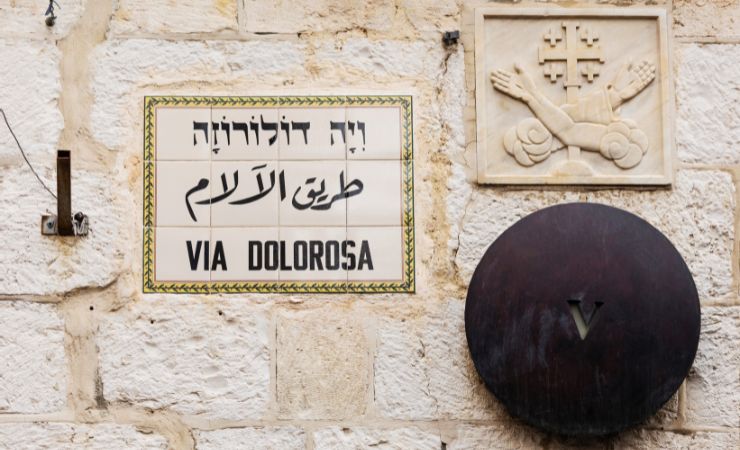
The Origins of the Via Dolorosa
While the Via Dolorosa holds immense spiritual significance for many believers, its exact route and the authenticity of each station are based on a combination of biblical accounts, historical records, and centuries-old Christian traditions.
Historical sources trace the birth of the term “Via Dolorosa” to the 13th century. In a document titled “L’estat de la citez de Iherusalem,” the street leading to the Temple is referred to as the “Sorrowful Gate” (in Old French: “Portes Doulereuses”). This is believed to be the gate through which Jesus Christ proceeded to Mount Calvary for his crucifixion. The same document also mentions other significant locations, such as the Monastery said to be the place where Jesus rested during his journey to crucifixion and the prison where he was held the night of his capture in Gethsemane.
Another account from 1286 by Fra Ricoldo da Monte Croce in his “Itinerario” describes the path Jesus took, mentioning specific places like the house of Herod, the house of Pilate, and the location where Jesus spoke to the women of Jerusalem.
However, the exact route and the events associated with the stations have evolved over time. The current 14 stations, as they are recognized today, were not universally agreed upon until more recent times. Pilgrims visiting Jerusalem over the centuries have followed various routes and identified different stations based on local traditions, available historical evidence, and religious interpretations. Over time, as pilgrims continued to walk this path, the Via Dolorosa became solidified in Christian tradition, making it a focal point of devotion and reflection for countless believers from around the world.
Station 1: Jesus is Condemned to Death
The first station of the Via Dolorosa marks the beginning of Jesus Christ’s final journey, a path filled with sorrow and suffering, leading to His crucifixion.
Location
The first station of the Via Dolorosa is situated near the Lions’ Gate on the eastern side of Jerusalem’s Old City, in the Muslim quarter. It is traditionally associated with the Church of the Flagellation, where it is believed that Jesus was scourged by Roman soldiers and crowned with thorns before His condemnation.
Biblical Context
The event of Jesus’ condemnation is recorded in the New Testament of the Bible, specifically in John 19:16: “Finally Pilate handed him over to them to be crucified.” This verse signifies the moment when Pontius Pilate, the Roman governor of Judaea, succumbed to the pressure of the crowd demanding Jesus’ crucifixion, despite finding no fault in Him.
Spiritual significance
The first station represents the beginning of Jesus’ Passion, His ultimate act of love and sacrifice for humanity. This station invites believers to reflect on the injustice of Jesus’ condemnation and the courage with which He accepted His fate. It serves as a stark reminder of the cost of our redemption and challenges us to confront our own moments of injustice and suffering with faith and resilience.
Station 2: Jesus Carries His Cross
At the second station of the Via Dolorosa Jesus is handed the heavy wooden cross that He will carry through the streets of Jerusalem. This is a symbol of the burden of mankind’s sins that Jesus is taking upon Himself.
Location
The second station of the Via Dolorosa is located near the Monastery of the Flagellation, where it is believed that Jesus was scourged and crowned with thorns. The station is marked by the Church of the Condemnation, which commemorates the moment when Jesus was handed His cross.
Biblical Context
The event of Jesus carrying His cross is described in the New Testament, specifically in John 19:17: “And He, bearing His cross, went out to a place called the Place of a Skull, which is called in Hebrew, Golgotha.” This verse signifies the moment when Jesus, after being condemned by Pontius Pilate, was handed the cross on which He would be crucified.
Spiritual significance
The second station represents the moment when Jesus willingly took up the cross, accepting the weight of humanity’s sins. It invites believers to reflect on the magnitude of Jesus’ sacrifice and the depth of His love for humanity. It serves as a reminder of the cost of our redemption and challenges us to carry our own crosses in life with faith and courage.
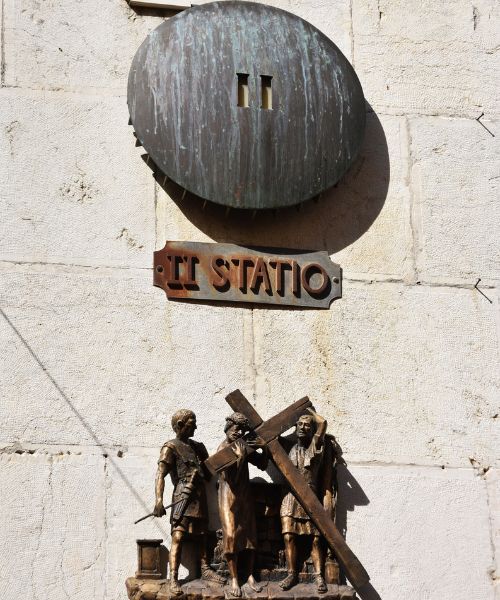
Station 3: Jesus Falls for the First Time
The third station of the Via Dolorosa marks a sad moment in the Passion narrative: the first time Jesus falls under the weight of the cross.
Location
The third station is situated on the Via Dolorosa, near the junction with the busy market street, Souq Khan al-Zeit. It is marked by a small chapel owned by the Armenian Catholic Patriarchate, which commemorates this significant event.
Biblical context
While the Gospels do not provide a specific account of Jesus falling during His journey to Calvary, Christian tradition has long held that Jesus fell three times under the weight of the cross. These moments are commemorated in the Stations of the Cross, a devotional practice that allows believers to meditate on the Passion of Christ.
Spiritual Significance
The third station holds deep spiritual significance as it underscores Jesus’ vulnerability and humanity. Despite being the Son of God, Jesus experienced fatigue, pain, and suffering, just like any other human being. His fall is symbolic of the weight of mankind’s sins and the immense love He had for humanity, willingly enduring such agony for our salvation. This station challenges believers to reflect on their own struggles and to find strength in perseverance and faith.
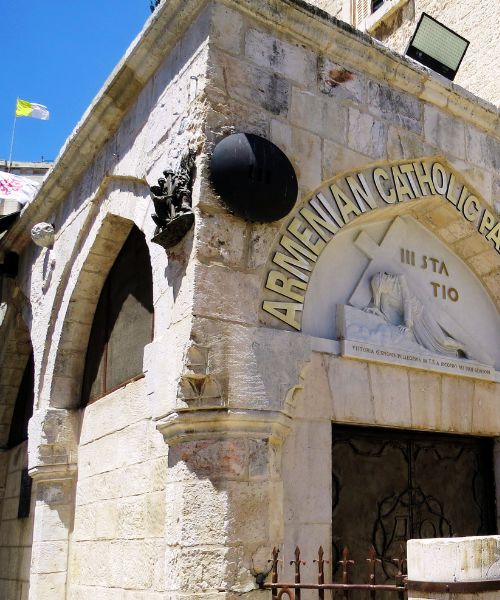
Station 4: Jesus Meets His Mother
Amidst the pain and suffering of the Via Dolorosa, the fourth station stands as a beacon of love and tenderness. Here, Jesus encounters His mother, Mary who witnesses her son’s agony.
Location
The fourth station is located by the Church of Our Lady of the Spasm, a place that commemorates this touching encounter. Inside the church, a Byzantine mosaic depicts two feet pointing northwest, believed to mark the spot where Mary stood as she gazed upon her suffering son.
Biblical context
While the Gospels do not provide a direct account of this encounter, Christian tradition has long venerated this moment. It’s a scene that captures the heartbreak of a mother witnessing her son’s suffering and the strength and solace they provide each other.
Spiritual significance
The meeting between Jesus and His mother is a powerful reminder of the depth of familial love and the strength it provides in times of adversity. This station offers a moment to reflect on the sacrifices made by both Jesus and Mary and the solace they found in each other. It’s a call to remember the importance of family, love, and support, especially during challenging times.
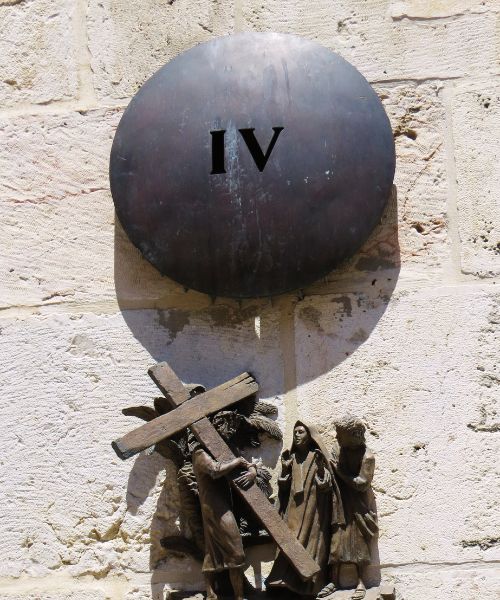
Station 5: Simon of Cyrene Helps Jesus Carry the Cross
The fifth station of the Via Dolorosa highlights a moment of compassion. At this station, Simon of Cyrene, a passerby, is compelled to assist Jesus by carrying the cross.
Location
The fifth station is marked by a plaque on the Via Dolorosa that commemorates this act of unexpected kindness and the place where their paths crossed.
Biblical Context
The Gospels of Matthew, Mark, and Luke recount the event where Simon of Cyrene is chosen by the Roman soldiers to bear the weight of the cross for Jesus. Specifically, Matthew 27:32 states, “As they were going out, they met a man from Cyrene, named Simon, and they forced him to carry the cross.“
Spiritual Significance
Simon, who was likely unfamiliar with Jesus, did not volunteer but was chosen. Yet, his act has become a symbol of the call to bear one another’s burdens. It emphasizes the importance of helping others, even in unexpected circumstances, and the impact that a single act of kindness can have.
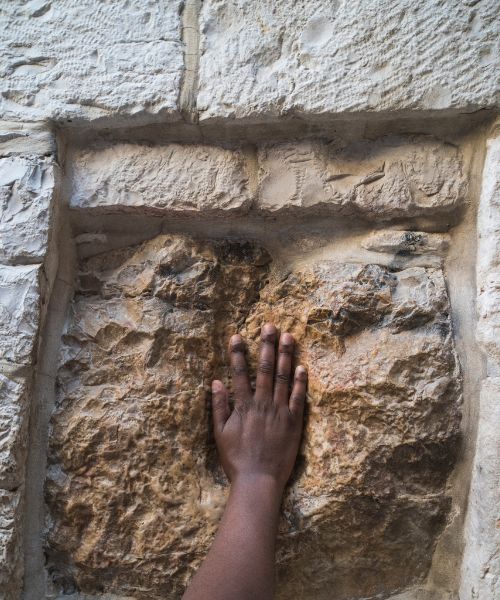
Station 6: Veronica Wipes the Face of Jesus
The sixth station of the Via Dolorosa marks a special moment in Jesus’ journey to Calvary: the compassionate act of Veronica.
Location
Along the western section of Via Dolorosa, just west of Al Wad St, you’ll Station six. It’s distinguished by a brown wooden door on the southern side and a distinct carving on the wall. The door is the entrance to a Greek Catholic chapel, Church of the Holy Face. This spot commemorates the moment when Veronica is said to have tenderly wiped the blood from Jesus’s face using a cloth.
Biblical Context
As Jesus trudged along the Via Dolorosa, burdened by the weight of the cross and the weight of the world’s sins, a woman named Veronica stepped forward. Moved by compassion and undeterred by the hostile crowd, she approached Jesus and tenderly wiped His face with her veil. This simple act of kindness amidst the brutality surrounding Jesus is a testament to the human capacity for compassion and love.
After Veronica wiped Jesus’ face, a miracle occurred. An imprint of His holy countenance was left on the cloth. This image, known as the “Vera Icon” (True Image), became a revered relic, symbolizing the very face of God’s love and suffering.
While the act of Veronica wiping Jesus’ face is not explicitly mentioned in the canonical Gospels, it has been a cherished tradition in Christian piety. The name “Veronica” itself is believed to be derived from the Latin words “Vera” (true) and “Icon” (image), emphasizing the authenticity of the divine imprint left on her veil3.
Spiritual Significance
This station reminds believers of the profound message that in the midst of suffering and pain, acts of kindness and love can shine brightly. Veronica’s act is a call to recognize Jesus in the suffering faces of our brothers and sisters and to respond with compassion.
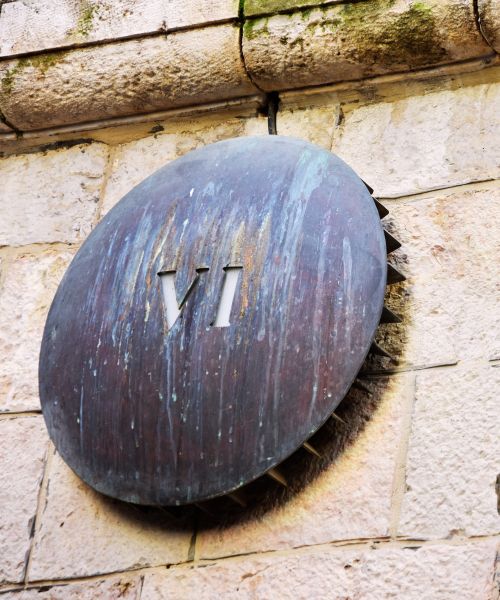
Station 7: Jesus Falls for the Second Time
At the seventh station of the Via Dolorosa, Jesus, weakened from the torture and the weight of the cross, stumbles and falls for the second time.
Location
The seventh station of the Via Dolorosa is at the corner of Via Dolorosa St. and Khan es-Zeit St. At this location a small Franciscan chapel was built housing a Roman column (tetrapyle) from the Roman Cardo (Cardo Maximus), from the time of Hadrian. This is the junction between the main cardo and the decumans from Roman times.
Biblical Context
Jesus’ second fall is not explicitly mentioned in the canonical Gospels. However, it has been embraced by Christian tradition as a representation of humanity’s repeated failures and sins. Just as Jesus rose after each fall, His journey reminds believers of the importance of perseverance, hope, and the promise of redemption.
Spiritual Significance
The seventh station invites pilgrims and believers to reflect on their own moments of weakness and the times they’ve stumbled in their spiritual journey. Jesus’s second fall, near a Roman column that stands to the right of an altar, reminds us of the profound physical and spiritual exhaustion Jesus experienced. It’s a call to recognize our human frailties but also to remember the boundless mercy and love of God, who lifts us up each time we fall.
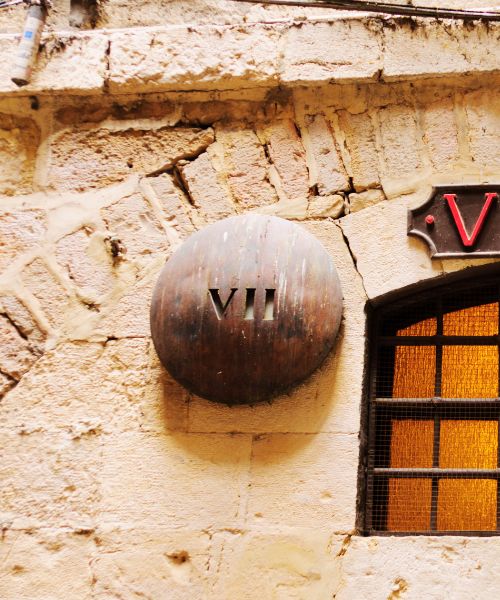
Station 8: Jesus Speaks to the Women of Jerusalem
the eighth station of the Via Dolorosa marks a poignant moment in Jesus’ journey to Calvary. Here, amidst the weight of the cross and the pain of His wounds, Jesus pauses to address a group of mourning women.
Location
Just a brief walk up Aqabat Al Khanqah St from Souq Khan Al Zeit St. The eight station is marked with a stone with a Latin cross embedded in the left wall, highlighted by a red sign.
Biblical Context
As Jesus made His way through the streets, a large number of people followed Him, including women who mourned and wailed for Him. Despite His own suffering, Jesus turned to them and said, “Daughters of Jerusalem, do not weep for Me; weep for yourselves and for your children” (Luke 23:27-28). This moment underscores Jesus’ selfless nature, emphasizing His concern for others even in His darkest hour.
The women of Jerusalem, moved by the sight of Jesus’ suffering, openly expressed their grief. Their tears were not just for Jesus the man, but for what His suffering represented – the cost of humanity’s redemption. Yet, Jesus’ words to them were both a warning and a prophecy, hinting at the future destruction of Jerusalem and the hardships its inhabitants would face.
Spiritual Significance
The eighth station serves as a reminder of Jesus’ boundless compassion and His ability to look beyond His own pain to address the suffering of others. For believers, it’s an invitation to reflect on their own lives, to consider the times they’ve been consumed by their own problems and missed the opportunity to comfort or help someone else in need.

Station 9: Jesus Falls for the Third Time
As Jesus made His way to Calvary, the physical and emotional toll became evident. The ninth station marks the third time that Jesus fell under the weight of the cross.
Location
The nineth station of Via Dolorosa is identified by Roman letters and a cross on a column set into the wall. This location there is a small Coptic Church, St. Helen at this location. The Coptic represent the Christians from Egypt.
Biblical Context
The Gospels do not provide a detailed account of each time Jesus fell. However, the tradition of the Stations of the Cross has preserved this poignant moment, emphasizing the immense suffering Jesus endured for humanity. The repeated falls, especially the third, symbolize the weight of our sins and the depth of Jesus’ humanity.
Spiritual Significance
Christ’s weakness was extreme, and the cruelty of His executioners was excessive. They tried to hasten His steps when He had scarcely the strength to move. This moment serves as a profound reminder of the physical and emotional pain Jesus endured. It calls us to reflect on our own lives, the times we’ve fallen, and the strength we find in Jesus to rise again.
Station 10: Jesus is Stripped of His Garments
The tenth station of the Via Dolorosa holds a somber moment: Jesus is stripped of his garments.
Location
The tenth station located inside the Church of the Holy Sepulchre in a room called the Chapel of the Franks.
Biblical Context
The Gospel of John provides a vivid account of this event. Upon reaching Golgotha, the place of the skull, the soldiers who had crucified Jesus took his garments and divided them into four parts, one for each soldier. They also took his tunic, which was woven without seam from top to bottom. Instead of tearing it, they decided to cast lots to determine who would get it. This act fulfilled the scripture: “They parted my garments among them, and for my clothing, they cast lots” (John 19:23-24).
Spiritual Significance
Stripping Jesus of his garments was more than a mere act of cruelty; it was symbolic. Clothing often represents one’s social status and identity. By removing his clothes, Jesus was rendered vulnerable, exposed, and humiliated in front of onlookers. This act can be seen as a reflection of humanity’s fall from grace, reminiscent of Adam and Eve’s expulsion from Paradise and their realization of their nakedness.
Yet, in this profound moment of vulnerability, Jesus’s true kingship shone through. He stood as the poorest king, owning nothing, not even the clothes on his back. But in his poverty, he was rich, for he possessed the boundless love of his Father.
In today’s world, where material possessions and outward appearances often define one’s worth, the tenth station serves as a powerful reminder. True richness doesn’t lie in what we have, but in who we are and whose we are. By detaching ourselves from worldly desires and pride, we can find true wealth in the love and grace of God.
In the words of a reflection on this station: “Behold, the poorest king who ever lived. Before my creatures, I stand stripped. The cross — my deathbed — even this is not my own. Yet who has ever been so rich? Possessing nothing, I own all — My Father’s love“.

Station 11: Jesus is Nailed to the Cross
Station eleven marks the moment when Jesus was nailed to the cross.
Location
Station 11 is situated in the Church of the Holy Sepulchre at the Franciscan altar on Calvary. This alter was built in the 20th century by architect Antonio Barluzzi.
Biblical Context
The Gospels recount the harrowing journey of Jesus as He was led to Golgotha, the site of His crucifixion. At Station 11, the scriptures tell us of the agonizing moment when Jesus was nailed to the cross. The Gospel of John states: “There they crucified him and with him two others, one on either side and Jesus between them. Pilate also wrote a title and put it on the Cross; it reads; ‘Jesus of Nazareth, the King of the Jews.’” (John 19:18-19).
Spiritual Significance
The act of Jesus being nailed to the cross is a profound moment in Christian theology. It symbolizes the immense sacrifice and love of Jesus for humanity. By bearing the physical pain of the nails and the weight of the world’s sins, Jesus exemplified selfless love and sacrifice. This station serves as a somber reminder of the extent of His suffering and the depth of His love. For many believers, reflecting on this station is an opportunity to contemplate the gravity of Christ’s sacrifice and to deepen their personal connection with Him. It’s a call to recognize the weight of one’s actions and to seek forgiveness and redemption.
Station 12: Jesus Dies on the Cross
Station twelve is a sacred spot that marks the place where, according to Christian belief, Jesus was crucified and gave up His life for humanity’s salvation. The gravity of this moment is a cornerstone of Christian belief.
Location
The twelfth station is located within the Church of the Holy Sepulchre next to station eleven. It is administered by the Greek Orthodox church. At the site there is an alter positioned above the site where the Cross was placed on Cavalry (Golgotha) according to tradition.
Biblical Context
The Gospel of John provides a detailed account of Jesus’ final moments on the cross:
“That the Scriptures might be fulfilled, Jesus said: ‘I thirst.’ A bowl of Vinegar stood there; so they put a sponge of Vinegar on Hyssop and held it to his mouth. When Jesus had received the Vinegar, he said, ‘it is finished!’ and he bowed his head and gave up his spirit.” – John 19:28-30
Spiritual Significance
The twelfth station is a profound reminder of the depth of Jesus’ love and sacrifice. His declaration, “it is finished,” signifies the completion of His earthly mission and the fulfillment of prophecies. For many believers, this station represents the heart of their faith, emphasizing redemption, grace, and the boundless love of God.
Station 13: Jesus is Taken Down from the Cross
Station 13 is marks the moment when Jesus’ lifeless body was taken down from the cross.
Location
Station 13 is situated within the Church of the Holy Sepulchre in Jerusalem. It is marked with a wooden statue of Many with a sword stabbing her in the heart. This statue was donated by the Queen of Portugal in 1778.
Biblical Context
The Gospels recount that after Jesus breathed his last on the cross, and before being taken down from the cross, he was stabbed in the ribs by a Roman soldier to make sure he was dead. Blood and water flowed from the opening. Then, a man named Joseph of Arimathea, a secret disciple of Jesus, requested Pontius Pilate for Jesus’ body. After obtaining permission, he took Jesus’ body down from the cross. This act of Joseph is significant as it fulfilled the prophecy from Isaiah 53:9 which stated that the Messiah would be buried with the rich.
Spiritual Significance
The act of taking Jesus down from the cross is a somber reminder of the immense sacrifice He made for humanity. For believers, this station serves as a reflection on the depth of God’s love and the extent of Jesus’ suffering. It’s a moment to ponder on the weight of sin and the price that was paid to redeem mankind.
Station 14: Jesus is Laid in the Tomb
The final station of the Via Dolorosa, Station 14, marks the solemn moment when Jesus is laid to rest in the tomb. This is the Edicule with the empty tomb of Christ.
Location
The tomb, also known as the Edicule, is a small structure housing the remains of the burial chamber where Jesus was laid to rest. Over the centuries, the Edicule has undergone various restorations, but its significance remains unchanged.
Biblical Context
The Gospels recount that after Jesus’ death on the cross, Joseph of Arimathea, a wealthy man and secret disciple of Jesus, requested Pilate for Jesus’ body. He took the body, wrapped it in a clean linen cloth, and placed it in his own new tomb that he had cut out of the rock. He then rolled a big stone in front of the entrance to the tomb and went away (Matthew 27:57-60).
Spiritual Significance
The laying of Jesus in the tomb is a somber moment that concludes the events of His Passion. It signifies the apparent end of all hope as the Messiah is sealed away. However, for believers, this station also holds the promise of resurrection and the victory over death. It’s a testament to the Christian belief in eternal life and the hope that death is not the end but a transition to a new beginning.
Station 14 of the Via Dolorosa serves as a culmination of the journey, a place of deep reflection and anticipation of the joy of the Resurrection. It’s a reminder of the cyclical nature of despair and hope, death and life, and the enduring promise of redemption.




Sources and Additional Reading
Via Dolorosa – the way of grief – BibleWalks 500+ sites
Origins of the Via Dolorosa
The Via Dolorosa – Jerusalem in 3 minutes
Via Dolorosa App
Vatican: Station 1, Station 2, Station 3, Station 4, Station 5, Station 6, Station 7, Station 8, Station 9, Station 10, Station 11, Station 12, Station 13, Station 14
Nearby Sites
Lion’s Gate: The Lion’s Gate, also known as St. Stephen’s Gate, is one of the seven open gates in Jerusalem’s Old City walls. It’s named after the pair of lion symbols carved into the gate’s façade.
The Tomb of the Virgin Mary: The Tomb of the Virgin Mary is a sacred Christian burial site dedicated to Mary, the mother of Jesus.
St. Anne’s Church Jerusalem: St. Anne’s Church is a beautifully preserved Roman Catholic church, close to the Lion’s Gate. It’s believed to stand over the birthplace of the Virgin Mary.
- Ecce Homo Arch: The Ecce Homo Arch is part of a triumphal gateway built by the Romans in the 2nd century CE. It was believed to be the place where Pontius Pilate presented Jesus to the crowds with the words “Ecce Homo,” which means “Behold the Man” in Latin.



